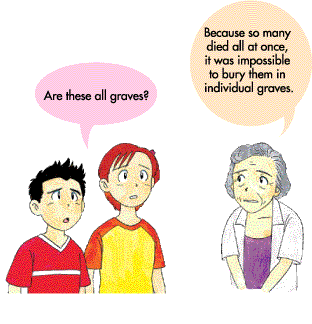 |
| Sending off the Dead |
| The injured died one after the next. Starting with the day of the bombing, disposal of bodies continued until the emergency field hospital was closed. Any nametags affixed to the dead were collected along with locks of hair and belongings. These were placed in envelopes with the victims' names on them and set aside for safekeeping. The bodies were piled up in and around the grounds of the quarantine station, but there were too many to cremate. Many were carried into bomb shelters dug into cliffs and buried. The most seriously injured died without revealing their names; thousands were never identified. |
 |
25 Corpses covered with straw mats just before being taken away Drawing and text / Miyae Kageyama August 6, 1945, Ninoshima Quarantine Station The soldiers could not keep up with the bodies needing to be taken away. In the meantime they covered the dead with straw mats. The soldiers would make a large pile of bodies and pour oil them. Lighting the fire ignited a sea of flame. When I think of human beings ending their lives this way, all I can do is shed tears and put my hands together in prayer." Excerpt from the memoir "My Experience" |
 |
 |
| 26 Soldiers carrying bodies away from the pier Drawing and text / Masako Ishifuro August 7, 1945, about 10:00 a.m., Ninoshima Quarantine Station Looking toward the dock, I saw large boats coming in filled with dead. They put them on stretchers and carried them on their shoulders behind a ridge. When I tried to follow, I was told, 'No entry.' I shed tears and put my hands together in prayer." Excerpt from her memoir |
27 Cremation of unknown numbers of dead Drawing and text / Kazumi Takeda August 8, 1945, Ninoshima Quarantine Station "A large trench was dug near the ward. The dead were piled into it, covered with oil and ignited. The smoke billowed high into the sky. Many were unidentified. The terrible odor lasted for days." Excerpt from his memoir |
| 28 Grave marker with "1000-Person Mound" written in India ink Photo / Shunkichi Kikuchi Courtesy / Tokuko Kikuchi October 17, 1945, Aza Majidomari, Ninoshima-cho This mound was by the sea in Majidomari near the Horse Quarantine Station. About August 25, 1945, the marker was placed there by quarantine staff during a memorial service. In those days, burial sites were everywhere. |
||
 |
||
 |
||
| Victims who died on Ninoshima |
|
|
||||||||||||
|
|
||||||||||||
|
|
||||||||||||
|
|
||||||||||||















